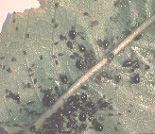
II. Hosts: Although it can survive on wild cherries, the BCA prefers commercial cherry varieties. While it will infest and feed on tart cherry, it greatly prefers sweet cherry varieties. `Napolean', `Black Tartaria', `Schmidt', and `Windsor' are the most susceptible varieties to injury from this insect, while `Dikeman' and `Yellow Spanish' are not seriously injured. Tart cherry varieties such as `Montmorency', `Early Richmond' and `English Morello' are attacked less frequently, and when attacked the injury is slight. Alternate summer hosts include water cress, peppergrass and other members of the mustard family.
III. Description: The adults and nymphs are readily identified by their shiny black coloration (photo above), since no other aphid of this color attacks cherry. The adults are soft-bodied insects that measure about 1/8 inch (3.2 mm) in length and exist in both winged and wingless forms. The nymphs are smaller in size, but are otherwise identical in appearance to the wingless adults. The shining black, oval eggs are extremely small, less than 4/100 inch (1mm) in length.
IV. Biology: The BCA overwinters as an egg on the bark of small branches. The eggs start to hatch as soon as the buds begin to open (April) with the young female aphids moving into the buds to feed on any exposed foliage. Within three to four weeks, the wingless female aphids called "stem mothers" rapidly establish colonies on the new growth by giving live birth parthenogenetically (without mating with males) to more wingless females. Two or three generations are usually produced on cherry during the season. By mid summer (early July), winged females develop and migrate to alternate hosts, mainly of the mustard family, but a few aphids will remain on cherry during the entire season. Several generations are produced on the alternate hosts. In the fall, usually in September and October, winged males and females fly back to the cherry orchards to mate and lay the overwintering eggs.
V. Injury: Except when present in very
high
densities, the colonies are found on the underside of the leaves of
growing
shoots. The adults and nymphs feed by sucking the sap out of the leafs
and tender shoots. Feeding causes a curling and stunting of the leaves
and growth distortions in the stem (Plate 132). Heavy infestations may
kill young trees and reduce the quantity and quality of the crop on
mature
trees by stunting tree growth and vigor. High aphid populations have
been
known to limit fruit set in the following year and the sticky waste
products
(called "honeydew") secreted by the aphids spots the foliage and fruit
and promotes the growth of a black, sooty fungus.
VI. Monitoring: Controls are directed against the stem mothers early in the spring (prebloom) by using contact or systemic aphicides. The presence of BCA is easy to detect on actively growing shoots because of the leaf curling of infested leaves. When densities of aphids are low only a few leaves per shoot will be infested. As the populations increase, the older leaves of the shoot will also support aphid colonies so that the proportion of infested leaves on a shoot will increase. In most commercial orchards, the BCA is controlled by insecticides applied for other insects in the prebloom period. Young trees with a limited insecticide program are the most susceptible to injury and may require additional monitoring and treatment. There are many natural enemies of this aphid, including syrphids, lacewings, and lady beetles, that may supplement control in the orchard if given enough time to work. No economic thresholds for BCA have been developed, but young trees can withstand very little injury.